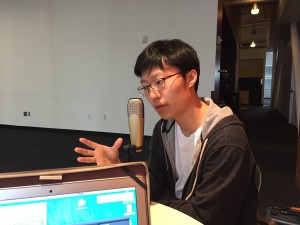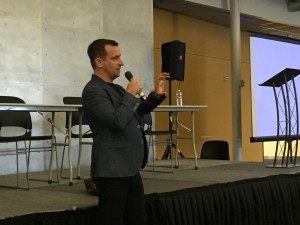Words and photos by RePlay contributor Bob Cooney.

Jeremy Lam – organizer of the VR Arcade conference and CEO and founder of the Virtual World Arcade. Jeremy is passionate about VR, and is working to bring pop-up VR experiences to arcades and FEC’s. His first location in Silicon Valley opened right before the event.
The inaugural VR Arcade conference took place this week in Mountain View, Calif., at the Computer History Museum. The brainchild of Jeremy Lam, founder and CEO of startup Virtual World Arcade, the conference was designed to bring together manufacturers, content creators, platform developers and others who make up the VR ecosystem, in the hopes of connecting the dots to accelerate the market readiness of VR experiences for the out-of-home market.
As is to be expected for a first time event by a relatively unknown organizer, VR Arcade Conference was lightly attended. Less than 100 people rattled around the relatively large conference hall, which was also littered with product demonstrations. VR Arcade featured panel discussions, some deep-dive presentations, a dozen or so product demos and a hack-a-thon. Stretching the conference out to three days might have been too aggressive in hindsight, though.

Wyatt Bushnell – CEO and Founder of Virsix. Wyatt (yes another offspring of Nolan) is shipping a single player VR arcade experience.
General consensus was that while there were some good ideas presented, most are still conceptual. Those that are being implemented, like adding VR headsets to amusement park roller coasters, are so early-stage that nobody has any results yet (“It’s cool!” or “People seem to like it” are not results) The product demos weren’t really products. Most were prototypes and none had reached commercial scale yet.
Free-roaming VR seems to be something many are chasing. It requires accurate and low-latency motion tracking as to not make people feel ill. Many of the products on display fell woefully short of this standard. One made me feel like I was drunk; after trying to take a few steps without stumbling, I had to immediately take the headset off. Another had me hovering ten feet over the floor and I was afraid to take a step for fear of plummeting in the virtual world.

Tim Ruse – CEO of Zero Latency. Zero Latency was the only company at the conference actually running a retail virtual reality operation. They’ve sold 7000 tickets since opening in August at AU$88 per game, booked out four to six weeks in advance. Needless to say there were lots of questions.
The good news is that these experiences, when done correctly (as Zero Latency from Australia, The Void in Utah and VRCade in Seattle have) can feel real enough to blur the reality/fantasy border in our minds. They can be powerful, emotional and exhilarating. But with that comes responsibility and a requirement to deliver a very well designed and technically precise product. None of the companies that were demonstrating products at this first VR Arcade Conference were there yet, in my opinion. But it is still in the early days.
RePlay has its eye set on fully examining the potential impact this new technology may have on the amusement industry. In an upcoming issue, Cooney will be writing a full report on the conference, and
RePlay’s Casey Minter will write a profile featuring the aforementioned, Seattle-based VRCade.



